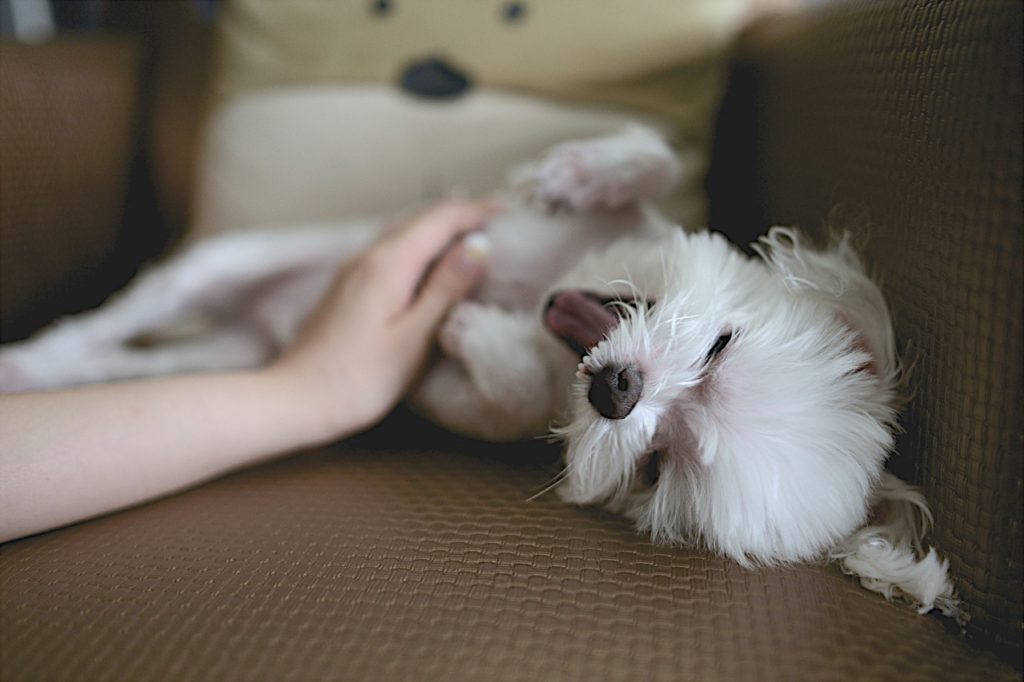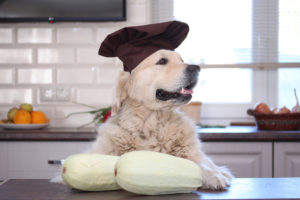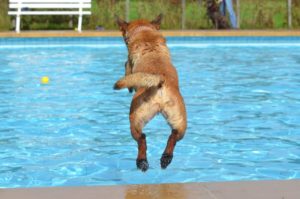Let’s set the stage. You’re sitting on the floor, watching a movie, when your dog comes over and flops beside you. Or maybe you’re outside enjoying a beautiful day when you see your pup roll over, digging their shoulders into the grass. One thing’s certain: they have that furry belly exposed for you. And you know what that means. Dogs love belly rubs, and we love obliging them. But why? What drives the enjoyment – for both of us? The science is actually pretty simple.
Belly Rubs: It’s All in the Brain
The majority of dogs love belly rubs. And it shows. You see their tongues hang out of their mouths, their eyes squint happily, and their tails wag. It’s a happy moment in the day (or ten moments out of the day, depending on your particular pup). Dogs seek us out. And we enjoy giving belly rubs.
Why? Well, both of us are getting boosts of oxytocin. Oxytocin is the “happy” hormone in the brain. It makes you relax, and you feel a rush of endorphins – the chemicals that relieve stress. As you deliver a belly rub, you brush hair follicles on your dog’s stomach. The nerves in the follicles send signals to the brain that trigger that oxytocin release. This pathway is found in all mammals – even us. (If you’ve ever felt someone stroke your hair, you know what I’m talking about)
While scientists aren’t positive how the feedback loop got started in the first furry mammalian ancestors, they think it came from social grooming. As animals learned to perform allogrooming, they increased proper hygiene in their groups. And if they get to feel happy about the process, they were more likely to continue.
We have tiny hair follicles on our hands that receive the same triggers as our canines. So – boom! Belly rubs make everyone happy.
“Belly rubbing is a comforting action. It’s an opportunity for bonding and part of our relationship with our dogs.”
~Peter Brown, DVM, Chief Medical Officer of Wagly
The Scratch Reflex
Of course, nerves play another role in belly rubs. You’ve probably glimpsed your dog kicking their leg out when you hit that “magic spot.” People like to laugh that they’re tickling their pup (which sounds better than getting them to kick). However, the kicking of your dog’s leg is an involuntary reflex. As you hit specific nerves, you trigger the scratch reflex. It’s like the reflex you demonstrate when a doctor uses a rubber hammer on your knee – you can’t help it. (At least, that’s how you’re SUPPOSED to react)
For your dog, the nerves are trying to get rid of an irritant. They relay a message to the spinal cord, and the legs kick in response. It’s a faster response than waiting for the brain to process all of the information, allowing canines to avoid potential dangers. (All reflexes behave in this manner, in case you wondered) Your dog isn’t injured when you hit that spot, and you won’t irritate them. You also can’t prevent the scratch reflex. It’s hard-wired into their system. But now you know WHY they kick.
Health Benefits
As it turns out, belly rubs offer both of us some extras – beyond that rush of oxytocin and endorphins. As you pet your dog, their blood pressure and heart rate slow down (after all, this is STRESS RELIEF). The same relaxation goes on in YOUR body. They’re health benefits that can improve your life, and they’ve been confirmed with scientific studies.
As the two of you lock eyes during a belly-rubbing session, you also experience an extra boost of oxytocin. While you’re getting a feeling of happiness, you’re also enhancing the bond between you. It’s similar to the feedback loop experienced by mothers and their babies. And research has confirmed that fact, too! (So never let anyone say your dog isn’t your baby)

Belly Rubs: A Question of Trust
When a dog rolls over and presents their tummy to you, they’re actually demonstrating A LOT of trust. Being upside down in front of a larger individual is a submissive position. In the wild, canines adopt the position to other members in the pack to say, “I’m not a threat to you.” And the body language means the same in your dog. (Remember, you’re the Alpha Dog)
This means belly rubs may or may NOT be a comfortable thing for some dogs. It’s important for you to pay attention to all of the signals your dog displays when they roll over. Are they asking you for that happy, bonding time? Or are they afraid and telling you they won’t hurt you?
“Please Give Me a Belly Rub!”
When a dog WANTS a belly rub, you’ll see very clear signs. Odds are you’ve established a firm bond of trust with your pup, and it’s become a common behavior. When it’s time to get down and start laughing, you’ll notice:
- A loose, wiggly body
- The mouth stays relaxed with a floppy, goofy tongue
- Their eyes are open and squinted in happiness
- The tail is relaxed and wagging
- You’ll hear the soft doggie laugh (or possibly nothing more than panting)
This is a happy dog.
“I’m Not a Threat”
On the flip side, not every dog’s experienced a positive upbringing. You should NEVER force a dog into belly rubs. Pushing a dog onto their back makes them feel frightened and vulnerable (it’s not a natural position for them). You’ll end up breaking that trust quickly. As a result, you’ll end up with a dog that comes to you in submission, which looks dramatically different:
- A tense, crouched body, frozen in anticipation
- The mouth is pulled into a grimace with a lot of lip-licking
- Their eyes stay WIDE open, sometimes focused on something (you); you may see the whites roll
- The tail tucks in tight
- You’ll hear whining
Obviously, you don’t have a happy dog. This is a submissive dog, assuring you they aren’t a potential threat. And you’re seeing clear signs of discomfort. You’re best bet is to STOP and let your pup move away. Not every dog enjoys belly rubs, which is okay.
Belly Rubs: Scratching the Itch
Canines have rolled around on their backs since before we domesticated them. In fact, some scientists believe WE invented belly rubs. As we noticed our canine companions rolling around on the grass, we started to scratch at their stomachs. When certain dogs permitted the behavior, it persisted. Before long, belly rubs took off in popularity – probably spurred on by those bursts of oxytocin.
But why were dogs rolling in the grass in the first place? Easy – they needed to scratch their backs and shoulders. It’s the easiest way for pups to reach those places. And when a human hand came along to scratch the stomach – a place they COULDN’T reach – dogs were happy to let us continue. So while we may have invented the belly rub out of curiosity, our canines probably relaxed over a problem solved. (Who DOESN’T appreciate someone reaching an itch they can’t reach?)
Time to Bond
When our dogs roll over, we can’t help but oblige them in a session of belly rubbing. It makes them feel good – as we can see – and it makes us feel good. Does every dog out there enjoy a belly rub? No, which is okay. You can work through training to slowly adjust a frightened dog to the process, or you can respect their decision. As long as you don’t reinforce the fear by FORCING them into a belly rub, you’re golden.
But when you have a pup who loves it, you know you’re in for a delightful session. Kicking, tongue-lolling and all!













No comment yet, add your voice below!